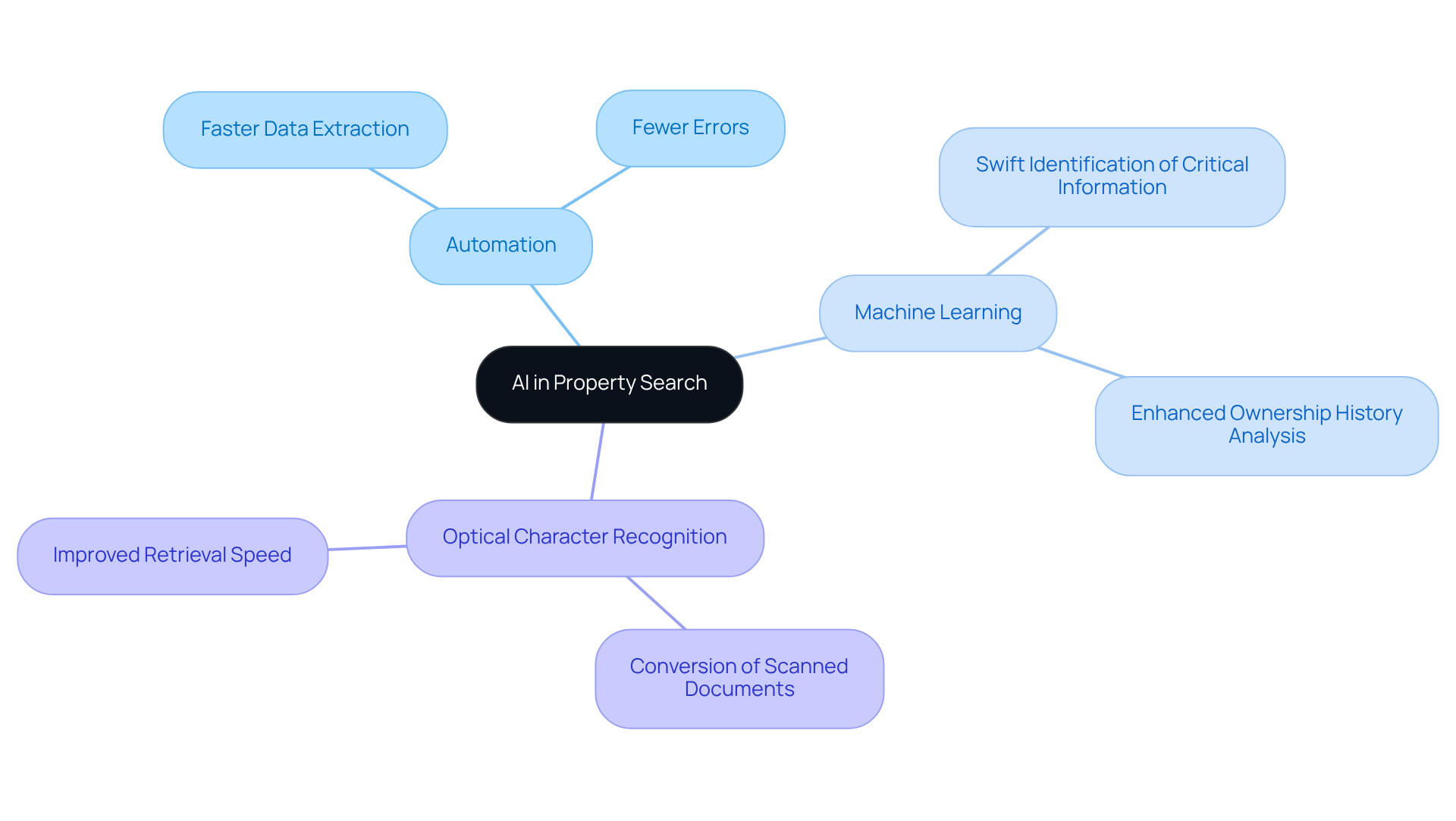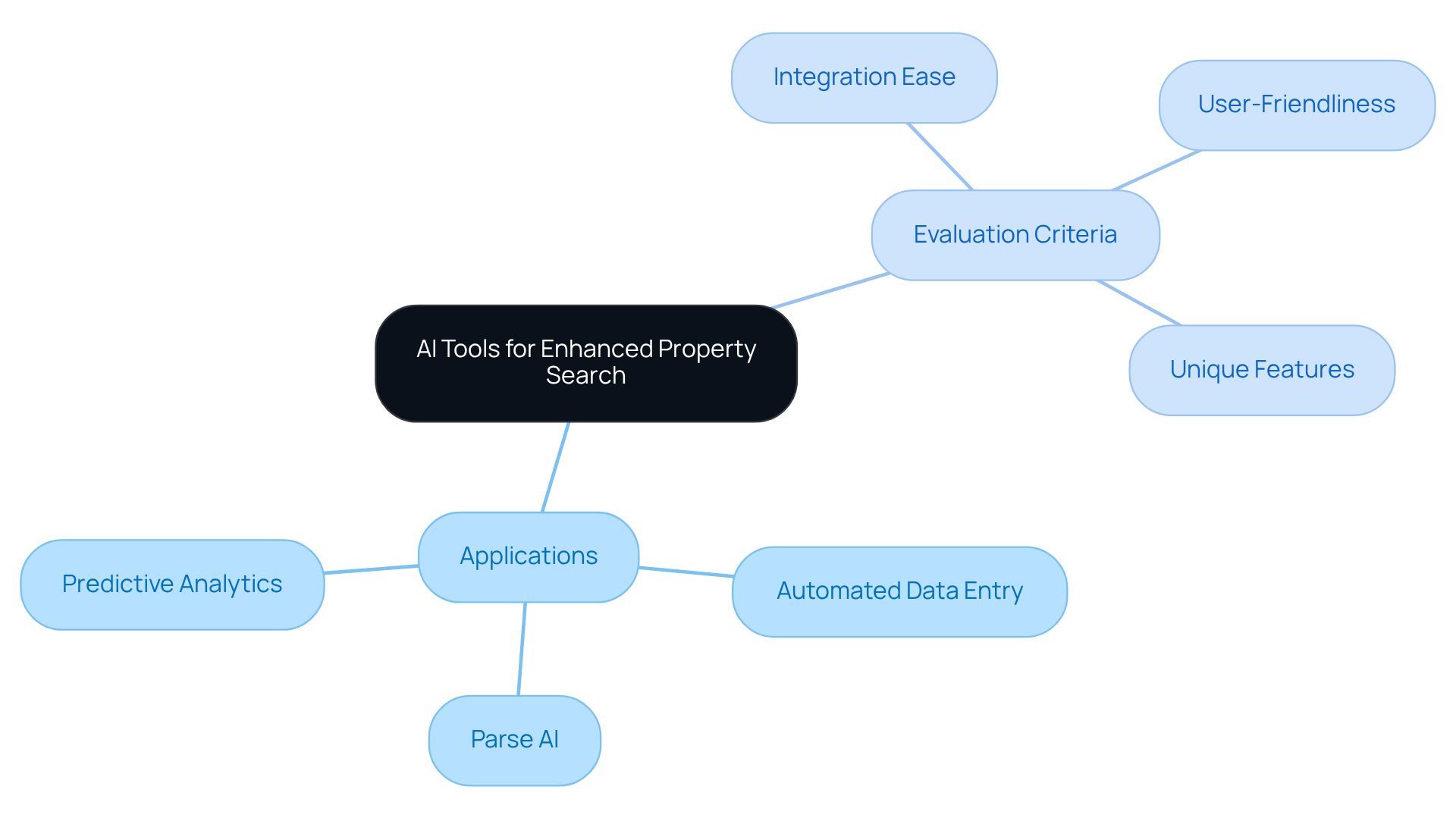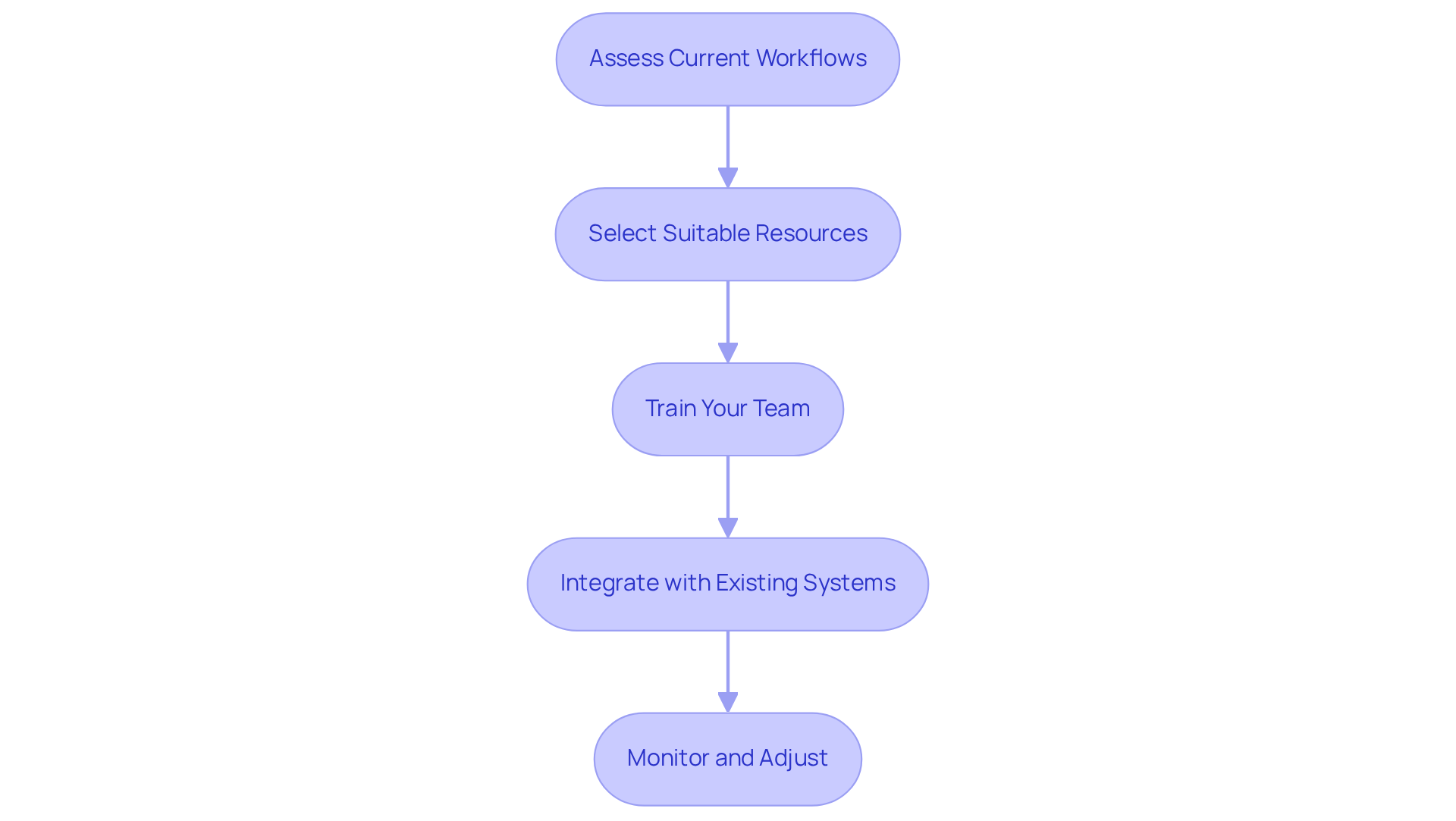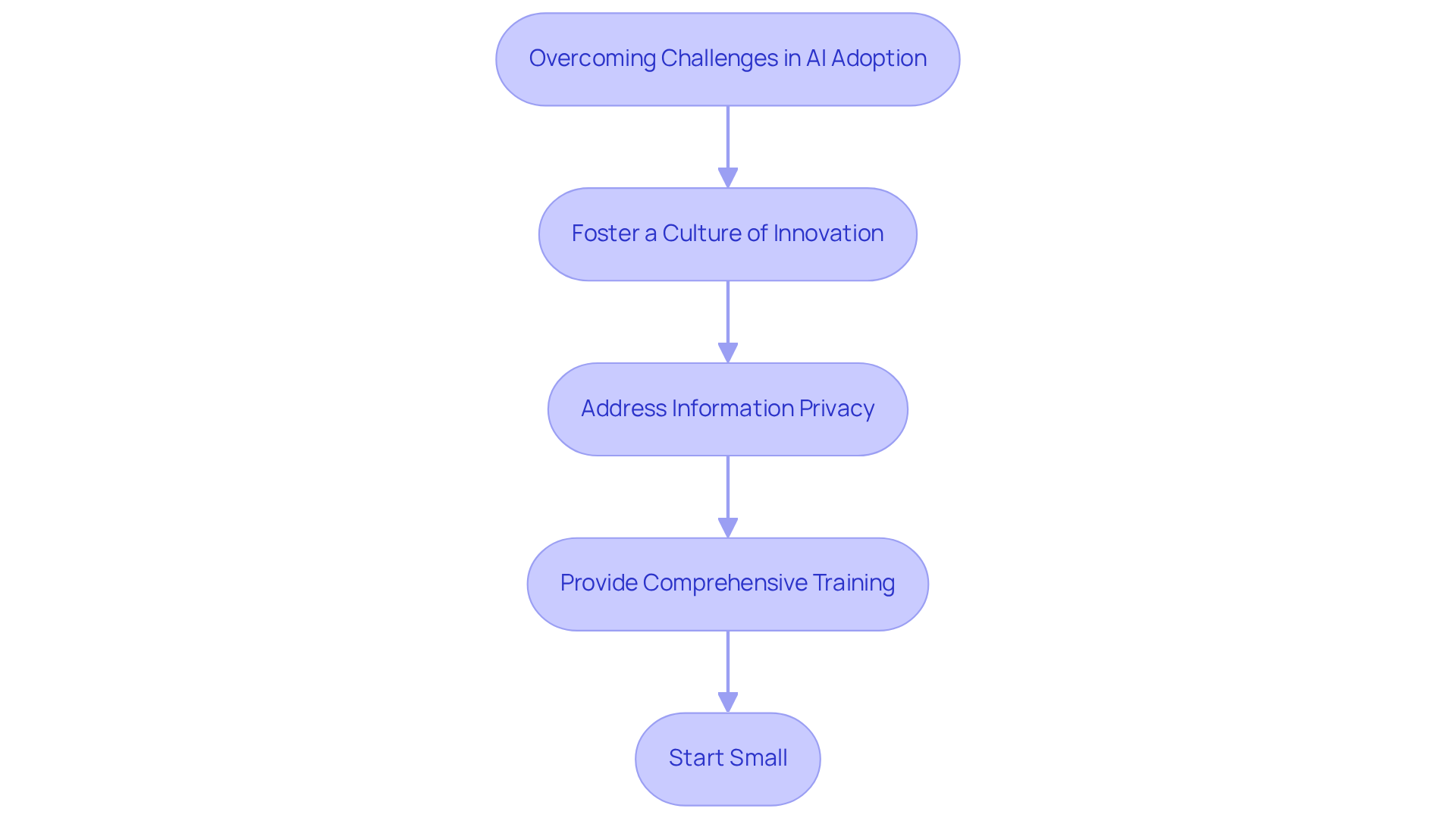Overview
AI enhances property search by automating the extraction and analysis of information from ownership documents. This innovation significantly boosts efficiency and minimizes human error in title research. The article elucidates how machine learning algorithms and optical character recognition (OCR) streamline workflows. Consequently, researchers can swiftly identify critical information, thereby improving the accuracy of property inquiries.
Introduction
AI technology is revolutionizing property searches, delivering unmatched efficiency and accuracy in a process that has long been labor-intensive. By automating the extraction and analysis of ownership documents, AI not only minimizes human error but also streamlines workflows for title researchers.
However, organizations aiming to integrate these advanced tools often encounter challenges that can impede their adoption.
How can title researchers effectively navigate these obstacles to fully harness the transformative power of AI in their workflows?
Understand the Role of AI in Property Search
AI significantly enhances property exploration procedures, demonstrating how AI improves property search by automating the extraction and analysis of information from ownership documents. Accurate title research is crucial, yet traditional methods often necessitate labor-intensive manual reviews of extensive records, resulting in inefficiencies and an increased potential for human error. In contrast, researchers can understand how AI improves property search by leveraging machine learning algorithms that swiftly identify critical information, such as ownership history, liens, and encumbrances. Furthermore, the integration of optical character recognition (OCR) enhances this workflow by converting scanned documents into machine-readable text, facilitating faster retrievals and improved accuracy. By harnessing these advanced capabilities, property researchers can markedly improve their efficiency and effectiveness in conducting property inquiries, demonstrating how AI improves property search.

Explore AI Tools for Enhanced Property Search
AI applications are specifically designed to show how AI improves property search processes. For example, Parse AI utilizes advanced machine learning algorithms to analyze document headers and efficiently extract essential information. Furthermore, automated data entry systems reduce manual input errors, and predictive analytics platforms help identify potential issues in property documents before they arise.
When evaluating these resources, researchers must consider factors such as:
- Integration ease with existing systems
- User-friendliness
- Unique features that address their specific challenges
A thorough assessment of these tools can reveal how AI improves property search and leads to significant improvements in workflow efficiency.

Implement AI Solutions in Title Research Workflows
To effectively implement AI solutions in title research workflows, consider the following structured approach:
- Assess Current Workflows: Begin by identifying bottlenecks and pinpointing areas where AI can provide significant value.
- Select Suitable Resources: Based on your comprehensive evaluation, choose AI solutions that align best with your specific needs.
- Train Your Team: Conduct training sessions to ensure that all team members fully understand how to utilize the new resources effectively.
- Integrate with Existing Systems: Collaborate closely with your IT department to guarantee a smooth incorporation of AI resources into your current software infrastructure.
- Monitor and Adjust: Following implementation, continuously monitor the performance of AI tools and actively gather feedback from users to make necessary adjustments.
This structured approach will empower researchers to maximize the benefits of AI within their workflows.

Overcome Challenges in AI Adoption for Title Research
Incorporating AI into title research presents notable challenges, including resistance to change, privacy concerns, and the necessity for technical training. However, effectively navigating these obstacles is essential for modernizing workflows. Consider the following strategies:
- Foster a culture of innovation by cultivating an environment where team members are encouraged to embrace new technologies by clearly communicating how AI improves property search, including increased efficiency and accuracy.
- Address Information Privacy: Prioritize adherence to protection regulations by implementing stringent security measures that safeguard sensitive details. This not only protects client data but also builds trust within the team.
- Provide Comprehensive Training: Offer continuous training and support to ensure staff are comfortable and proficient with new AI tools. This can include workshops, online courses, and hands-on sessions that reinforce learning.
- Start Small: Initiate pilot projects to showcase the effectiveness of AI solutions before committing to full-scale implementation. This approach allows for adjustments based on feedback and demonstrates tangible benefits to the team.
By proactively addressing these challenges, title researchers can facilitate a smoother transition to AI-enhanced workflows, ultimately leading to improved productivity and accuracy in their operations.

Conclusion
AI is revolutionizing the property search landscape, significantly enhancing the efficiency and accuracy of title research processes. By automating the extraction and analysis of crucial information from ownership documents, AI minimizes human error and streamlines workflows, allowing researchers to focus on more strategic tasks. The integration of advanced technologies, such as machine learning and optical character recognition, exemplifies how AI not only expedites research but also ensures a higher level of precision in property inquiries.
Throughout this article, the various dimensions of AI's impact on property search have been explored. From the introduction of specialized AI tools that facilitate data extraction to the structured implementation of these solutions, the discussion highlighted the importance of a methodical approach in adopting AI. Furthermore, overcoming challenges such as resistance to change and privacy concerns is essential for successful integration. Each of these points underscores the transformative potential of AI in the realm of title research.
Embracing AI technologies is not merely about keeping pace with innovation; it is about unlocking new levels of productivity and accuracy in property research. As the real estate industry continues to evolve, the adoption of AI will become increasingly critical. Researchers are encouraged to explore the latest advancements and best practices in AI tools, ensuring they are well-equipped to navigate the future of property search. By doing so, they can leverage AI's capabilities to enhance their workflows and ultimately deliver better outcomes in their endeavors.
Frequently Asked Questions
How does AI enhance property search processes?
AI enhances property search processes by automating the extraction and analysis of information from ownership documents, which streamlines the research process and reduces inefficiencies.
What are the limitations of traditional property search methods?
Traditional property search methods often require labor-intensive manual reviews of extensive records, leading to inefficiencies and a higher potential for human error.
What role do machine learning algorithms play in property search?
Machine learning algorithms swiftly identify critical information such as ownership history, liens, and encumbrances, improving the speed and accuracy of property research.
How does optical character recognition (OCR) contribute to property search?
Optical character recognition (OCR) converts scanned documents into machine-readable text, facilitating faster retrievals and improved accuracy in property searches.
What benefits do property researchers gain from using AI?
By leveraging AI's advanced capabilities, property researchers can significantly improve their efficiency and effectiveness in conducting property inquiries.




